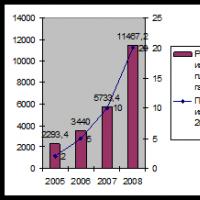The main problems and methods of evolutionary teaching. The main problems of the theory of evolution. Requirements for the design of materials for publication
Yaroslavl State Pedagogical University them. K.D. Ushinsky
by concept modern natural science.
Subject:
"Main Problems in the Theory of Evolution".
Students:
YaGPU them. Ushinsky
Kruglikova Love
Alexandrovna.
Speciality:
"Pedagogy and methodology
Teacher: Pizov
Alexander Vitalievich.
DO 2960, group 61 "D"
1. INTRODUCTION……………………………………………………………………………………3
2. 1 part. EARLYSTAGES OF DEVELOPMENT OF EVOLUTIONARY CONCEPTS.............................................................................................................4
3. THE THEORY OF EVOLUTION J.B. LAMARKA…………………………………………………………………………5
4. CHARACTER DARWIN’S THEORY OF EVOLUTION……………………………………………………..............6
5. part 2 . main problems of the theory of evolution. CRITICISM OF MODERN THEORY OF EVOLUTION BY CREATIONISTS………………………….10
6. GENERAL REMARKS ON THE THEORY OF EVOLUTION……………………………………………...13
7. MODERN PROBLEMS OF THE THEORY OF EVOLUTION…………………………………………………18
8. CONCLUSION………………………………………………………………………………23
9. LITERATURE………………………………………………………………………………..24
Introduction.
The basic fact of historical existence is that everything living and non-living comes and then disappears.
The galactic system itself did not always exist. She was born about ten billion years ago and will die at some point in the future. During the existence of our universe, it gradually gave life to the Sun, the Earth and some environment that can support the life that we know. It gave birth to the human race relatively recently, at most a few million years ago. In the time that billions of human beings have lived and died, we have collectively developed a civilization capable of landing a man on the moon.
Modern scholars usually rely on various theories evolution. According to modern ideas, life is the result of the evolution of matter. Views on the origin of life, its development and essence have a long history, but the discussion of these issues has until recently been the subject of philosophical reflection. Only in recent decades, the solution of these questions has been placed on an experimental basis, and the answer to many of them has been obtained in the laboratory.
In modern discussions around the problems of the theory of evolution, it is considered almost universally recognized that the theory of evolution encounters serious difficulties in explaining the phenomena of living nature and is not able to solve the problems that arise here. These problems include, in particular, the reality of speciation and macroevolution, the possibility of progressive improvement in evolution, the mechanisms of formation and transformation of complex structures in evolution, the expediency of the structure of living organisms. Stereotypical ideas about these sections of the theory of evolution are widely used by modern creationists to discredit science. Meanwhile, a discussion of the available data allows us to assert that in solving each of the above problems, the theory of evolution provides quite satisfactory explanations for the observed facts. These questions are more of a problem for creationism than for the theory of evolution.
In discussions around the problems of the theory of evolution, the same questions constantly emerge and are discussed, as is commonly believed, not resolved by the modern theory of evolution, such as, for example, the reality of speciation and macroevolution, the possibility of progressive improvement in evolution, the mechanisms of formation and transformation of complex structures in evolution, the expediency of the structure of living organisms. In all these cases, the theory of evolution provides fairly satisfactory explanations for the observed facts. In my opinion, these questions constitute a problem for creationism rather than for the theory of evolution. The relative weakness of modern evolutionism is not surprising. For many reasons, the theory of evolution is more closely connected with philosophy and ideological doctrines than other branches of natural science, and has long served as an arena for the struggle of supporters of the most diverse views.
As a result, ideas and entire systems of ideas that are recognized as true without the necessary justification are often fixed in evolutionary biology. They become a serious brake on the development of evolutionary research.
EARLY STAGES OF THE DEVELOPMENT OF EVOLUTIONARY CONCEPTS.
Ideas about the variability of the surrounding world, including living beings, were first developed by a number of ancient philosophers, among whom Aristotle (384-322 BC) enjoys the greatest fame and authority. Aristotle did not explicitly support the idea of the variability of the surrounding world. However, many of his generalizations, which by themselves fit into the overall picture of the world's immutability, later played an important role in the development of evolutionary ideas. Such are Aristotle’s thoughts about the unity of the structural plan of higher animals (the similarity in the structure of the corresponding organs in different species was called by Aristotle “analogy”), about the gradual complication (“gradation”) of the structure in a number of organisms, about the variety of forms of causality. Aristotle singled out 4 series of causes: material, formal, producing or driving, and target. The era of late antiquity and, especially the era of the Middle Ages that followed it, became a time of stagnation in the development of natural historical ideas that lasted almost one and a half thousand years. The prevailing dogmatic forms of the religious worldview did not allow the idea of the change of the world. The corresponding ideas of ancient philosophers were consigned to oblivion.
Creationism and transformationism.
Gradually, numerous data were accumulated that spoke of an amazing variety of forms of organisms. These data needed to be systematized. An important contribution in this area was made by the famous Swedish naturalist K. Linnaeus (1707-1778), who is rightly called the creator of the scientific systematics of organisms. It should be noted that Linnaeus consistently adhered to the point of view of the immutability of the species created by the Creator.
In the XVII-XVIII centuries. along with the dominant worldview based on religious dogmas about the immutability of the world created by the Creator and called creationism, ideas about the variability of the world and, in particular, the possibility of historical changes in the types of organisms gradually began to re-form. These ideas were called "transformism".
The most prominent representatives of transformism were naturalists and philosophers R. Hooke (1635-1703), J. Lamettry (1709-1751), J. Buffon (1707-1788), D. Diderot (1713-1784), Erasmus Darwin (1731-1802) , I.V. Goethe (1749-1832), E. Geoffroy Saint-Hilaire (1772-1844).
The transformists have not yet developed a holistic concept of the evolution of the organic world; their views were largely eclectic and inconsistent, combining materialistic and idealistic ideas. Common to all transformists was the recognition of the variability of species of organisms under the influence of the environment, to which organisms adapt due to their inherent ability to respond appropriately to external influences, and the changes acquired in this way are inherited (the so-called "inheritance of acquired traits"). At the same time, changes in species were not so much proven as postulated by the transformists, which made their positions weak in discussions with supporters of creationism. The honor of creating the first evolutionary theories belongs to the great naturalists of the 19th century. J. B. Lamarck (1744-1829) and C. Darwin (1809-1882). These two theories are opposite in almost everything: both in their general construction, and in the nature of the evidence, and in the main conclusions about the causes and mechanisms of evolution, and in their historical fate. These classical theories of the XIX century. continue to be relevant, albeit in different ways.
THE THEORY OF EVOLUTION J.B. LAMARK.
Jean-Baptiste Lamarck outlined the foundations of his concept in his most famous work, The Philosophy of Zoology (1809). The title of this book aptly emphasizes an important feature of Lamarck's generalizations—their speculative nature. This theory is a coherent edifice of logical constructs that provide answers to most of the basic questions of evolutionism, but these answers were found not so much by analyzing scientific (i.e., well-verified, reliable) facts, but were deduced logically from several basic provisions accepted as postulates. Such a philosophical approach is characteristic of the early stages of the development of science, when the accumulated facts already need logical comprehension, but they are still not enough for a rigorous scientific analysis and generalizations.
The variability of organisms.
Among these manifestations of variability, the most obvious were adaptive changes in organisms exposed to new conditions (for example, the development of plants of various shapes from identical seeds when grown under different conditions; strengthening of muscles in humans and animals with their increased exercise and weakening of these muscles in the absence of appropriate physical loads, etc.). General conclusion Lamarck from these observations was the recognition of historical variability, the transformation of organisms in time, that is, their evolution. However, this conclusion was no longer original: the historical transformation of species of organisms under the influence of changes in the external environment was recognized, as already noted, by all transformists. The doctrine of gradation. The variety of species of living beings, according to Lamarck, is not just a chaos of all kinds of forms - in this diversity one can see a certain order, as if the steps of a consistent and steady increase in the level of organization. From this, Lamarck made the most important conclusion that changes in organisms are not random, but regular, directed: the development of the organic world is in the direction of gradual improvement and complication of organization.
3rd international conference
« Contemporary Issues biological evolution»,
dedicated to the 130th anniversary of the birth of N.I. Vavilov
and the 110th anniversary of the founding of the State Darwin Museum
Institute of Problems of Ecology and Evolution. A. N. Severtsov RAS
Institute of General Genetics. N. I. Vavilov RAS
Paleontological Institute. A. A. Borisyak RAS
Institute of Developmental Biology N. K. Koltsova RAS
Department of Biological Evolution, Lomonosov Moscow State University M. V. Lomonosov
Department of Higher Nervous Activity, Lomonosov Moscow State University M. V. Lomonosov
State Darwin Museum
From October 16, 2017 to October 20, 2017, the State Darwin Museum hosted the III International Conference Modern Problems of Biological Evolution. 223 reports were submitted to the conference in 9 sections and 4 round tables.
Sections:
- evolutionary genetics
- View and speciation
- Intraspecific differentiation and adaptation
- Evolution of ontogeny
- Evolutionary morphology and paleontology
- Behavior evolution
- Community evolution, evolutionary biogeography
- History of evolutionary research
- Popularization of evolutionary theory and museum work
Round tables:
- Scientific heritage of N.I. Vavilov
- experimental evolution
- The common shrew in the focus of chromosomal evolution
- Theoretical aspects of evolutionary biology
Organizing Committee:
- Dgebuadze Yury Yulianovich
Doctor of Biological Sciences, Professor, Academician of the Russian Academy of Sciences, Head. Laboratory of Ecology of Aquatic Communities and Invasions IPEE RAS - Markov Alexander Vladimirovich
d.b.s., head. cafe Biological Evolution, Faculty of Biology, Moscow State University - Severtsov Alexey Sergeevich
d.b.n. Professor of the Department of Biological Evolution, Faculty of Biology, Moscow State University, Editor-in-Chief of the Bulletin of the MOIP (Department of Biological) - Mina Mikhail Valentinovich
Doctor of Biological Sciences, IBR RAS - Zorina Zoya Alexandrovna
d.b.s., head. cafe GNI Biofaka MSU - Feoktistova Natalya Yurievna
Doctor of Biological Sciences, Scientific Secretary of IPEE RAS - Kubasova Tatyana Sergeevna
Candidate of Biological Sciences, Deputy Director for Research, GBUK GDM - Bannikova Anna Andreevna
Ph.D., leading researcher cafe zool. vertebrates - Kolchinsky Eduard Izrailevich
Doctor of Biological Sciences, St. Petersburg. Phil. IIET - Kuznetsov Alexander Nikolaevich
Doctor of Biological Sciences, PIN RAS - Smirnova Anna Anatolievna
Ph.D., leading researcher cafe GNI Biofaka MSU - Smirnov Sergey Vasilievich
d.b.s., head. lab. IPEE RAS - Politov Dmitry Vladislavovich
d.b.n. head Laboratory of Population Genetics, IOGEN RAS - Zhuravlev Andrey Yurievich
d.b.s., prof. cafe biol. evolution of the Faculty of Biology of Moscow State University - Naimark Elena Borisovna
Doctor of Biological Sciences, Leading Researcher, PIN RAS - Klyukina Anna Iosifovna
Doctor of Pediatric Sciences, Director of State Budgetary Educational Institution of State Children's Museum - Rubtsov Alexander Sergeevich
PhD, Head n.i.d. evolution of GBUK GDM

Academician of the Russian Academy of Sciences, member of the scientific council of the Darwin Museum Yuri Yulianovich Dgebuadze.






 3rd international conference "Modern problems of biological evolution", dedicated to the 130th anniversary of the birth of N.I. Vavilov and the 110th anniversary of the founding of the State Darwin Museum.
3rd international conference "Modern problems of biological evolution", dedicated to the 130th anniversary of the birth of N.I. Vavilov and the 110th anniversary of the founding of the State Darwin Museum.
Institute of Problems of Ecology and Evolution. A. N. Severtsov RAS
Institute of General Genetics. N.I. Vavilov RAS
Paleontological Institute. A. A. Borisyak RAS
Institute of Developmental Biology N.K. Koltsov RAS
Department of Biological Evolution, Lomonosov Moscow State University M. V. Lomonosov
Department of Higher Nervous Activity, Lomonosov Moscow State University M. V. Lomonosov
State Darwin Museum
Information mail.
Dear colleagues!
We invite you to take part in the III International Conference "Modern Problems of Biological Evolution", which will be held October 16-20, 2017 at the State Darwin Museum.
Papers containing empirical research or theoretical reviews in the following areas are accepted for participation in the conference:
evolutionary genetics
View and speciation
Intraspecific differentiation and adaptation
Evolution of ontogeny
Evolutionary morphology and paleontology
Behavior evolution
Community evolution, evolutionary biogeography
History of evolutionary research
Popularization of evolutionary theory and museum work
The second problem of the evolutionary theory of biological species is related to the limits of applicability of Darwin's theory: what processes can it be extrapolated to (supporters of the evolutionist paradigm categorically extend it to the development of all living nature and even matter in general), whether it can be used to explain the emergence of life itself from inanimate, and also the emergence of new species? And if the emergence of new species proceeded through evolutionary changes, then where are the transitional forms?
Darwin himself understood this problem, noting that the number of intermediate varieties that once existed must be truly enormous. Why, then, is every geological formation and every layer not overflowing with such intermediate links? Indeed, geology does not reveal to us such a completely continuous chain of organization, and this is perhaps the most obvious and serious objection that can be made against his theory.
Today the situation is not much different. Here are the statements of modern scientists: “Paleontological evidence of evolutionary changes within the same line of inheritance is very scarce. If the theory of evolution is correct, then species arise as a result of changes in the precursor species and therefore the presence of fossil remains should be expected. In fact, however, there are very few such remnants. In 1859, Darwin could not give a single such example ”(M. Ridley). “Almost 120 years have passed since Darwin. During this time, our knowledge of fossil remains has expanded significantly. We now have a quarter of a million specimens of species fossils, but the situation has not changed significantly. The evidence for evolution is surprisingly sketchy. The irony of our position today is that we now have fewer examples of evolutionary transition than there were in Darwin's time” (D. Raup). “Forms that are transitional from one species to another can be observed today. It is possible to draw a conclusion about their existence in the past. And yet the end result is far from the perfectly woven tapestry in which the Tree of Life can be seen simply by tracing the intermediate links: both living and extinct creatures that connected all species together. Not at all. Biologists are much more struck by the discreteness of the organic form and the general absence of intermediate links ”(L. Morris).
Thus, one of the main problems of Charles Darwin's theory is the problem of the absence of transitional forms, which in the paradigm of universal evolutionism turns into the problem of qualitative leaps, which will be discussed below.
The third problem is related to the expediency of evolution.
In the teleological approach, expediency was explained by the fact that a certain internal goal of development is inherent in organisms. Either this goal is set by someone external - God.
Within the framework of Darwin's evolutionary theory, expediency is seen as the result of natural selection. As organisms develop, the process of interaction with environment, the stability of a population is determined by the possibility of adapting its individuals to external conditions, with changes in which the criteria of expediency also change. In organisms, we call expedient everything that leads to the continuation of the life of an individual or species, inexpedient - everything that shortens life.
The selection criterion in this case will be sustainability in relation to the external environment. Thus, according to Eigen, the randomness of the origin of the code of the DNA molecule is due to the criterion of stability in relation to environmental conditions, and the choice is made of one of the many possible alternatives.
In this interpretation, for expediency, no otherworldly is needed, everything is determined by natural laws.
Thus, expediency depends on the external environment and is determined by its conditions and state.
S.D. Haitong writes that evolution has no goal, but only a direction (vector) that determines the progress of evolution and is associated with changes, including the following:
Intensification of energy exchange and metabolism;
Intensification and expansion of cycles of energy and matter;
Growth of integrity (consistency) of structures;
Growth of connectivity of “everything with everything” and openness of systems;
- “floor-by-floor” increase in the complexity and diversity of forms;
An increase in the degree of non-Gaussianity of stationary and evolutionary time distributions;
Increasing degree of fractality of evolving systems and the Universe as a whole.
Thus, there is an increase in the complexity, hierarchy of evolving structures. This gave rise to scientists in the second half of the 20th century talking about the evolution of evolution itself. Nevertheless, as S.V. Meyen, in general, it can be said that although the problem of evolution deserves attention, it is apparently still very far from its meaningful development, and not just a list of statements.
Evolutionary theories themselves have also undergone evolution, which today has led to the formation of the main methodological concepts of the evolutionary-synergetic paradigm, which are the concepts of self-organization and global evolutionism.



